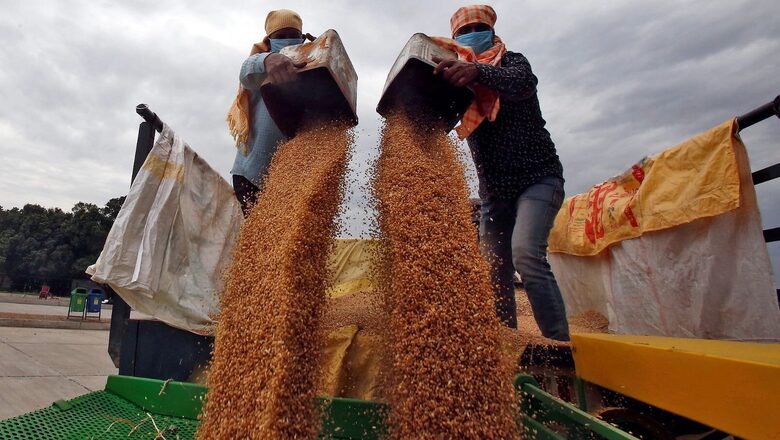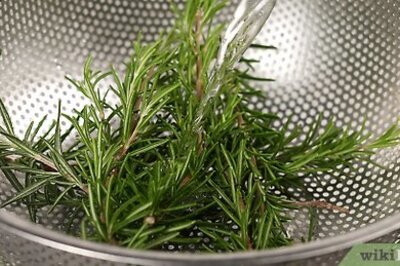
views
Struck by extreme weather events and record-breaking heat, India is facing an onslaught of climate change that has hit the yield of freshly harvested wheat, which has plunged significantly in two major wheat-procuring states of Punjab and Haryana.
The country has witnessed its hottest March in as many as 122 years, marked by an early onset of the heat wave. According to the India Meteorological Department (IMD), the month of March, which is also a crucial time for the growth of Rabi crops, saw the highest-ever average maximum temperature of 33.10℃, surpassing the previous record of 2010.
Farmers across the northern states of Punjab and Haryana rued yield losses of at least five to seven quintals per acre, with the grain size reducing significantly for one of the key food crops — wheat. This is of particular concern as Punjab contributes nearly 70 per cent to the central pool of food grains.
According to Patiala-based farm leader and Bharatiya Kisan Union (BKU-Dakaunda) representative Jagmohan Singh, farmers are reporting 13-14 quintals of grain from an acre of land that normally gave them at least 20 quintals. “Daana bareek ho gya hai (the grain has shrivelled). Last year, we recorded good production, but the yield has come down drastically by over 25 per cent this season due to unprecedented heat,” he says.
With crop productivity taking a hit, the ongoing wheat procurement also faced disruptions across several mandis in Punjab, as market agencies refused to accept the harvest on quality concerns, including lack of lustre. This has led farmers to demand relaxation in the current quality specifications laid down by Food Corporation of India (FCI) for wheat — permissible percentage for shrivelled grains (6%) and moisture content (of up to 14%).
Late on Tuesday, the Centre’s Department of Food and Public Distribution said it will constitute five teams to assess the extent of the problem in the state. According to Punjab government spokesperson, the teams will visit 15 districts across the state to get a first-hand assessment of the extent of shrivelled grains arriving in the mandis, to take a call on the farmers’ request.
Similar concerns were echoed by farmers in the neighbouring state of Haryana, where the crop faced the wrath of not only heat, but excess rains in January that flooded the crop fields. “Pehle barish ne kharab kar di kanak, fer garmi ne (First the rains spoiled the wheat, then the heat). Some farmers are even recording yields as low as 8-10 quintals per acre,” laments Haryana-based farm leader and BKU (Chaduni) working president Karam Singh Mathana. The farmers are now demanding monetary compensation to meet their losses.
Marred by Weather Extremes
According to scientists, the wheat grown in India is quite sensitive to temperature variations, and the current Rabi season (November-April) was marred by two extreme weather events. The intense rainfall spell in the first week of January powered by two successive western disturbances exceeded the total amount of rain that each of the two states receive usually over a month.
Ludhiana, for instance, saw a record 105mm rainfall in January, of which 100mm was recorded in the first week itself. Then the severe cold day conditions and overcast skies from January 5-16 reduced the required number of sunlight hours which eventually stunted the growth of crops.
Soon after, a grievous blow was lent by a long dry season starting mid-February marked by stark absence of any active western disturbance, and a spike in both day and night temperatures paving way for an early heat wave. According to IMD, the north-western plains witnessed a monthly rainfall deficit of as high as 89 per cent in March.
“These are all indications of climate change,” says Punjab-based agro-meteorologist Kulwinder Kaur Gill, adding that the state has seen good yields in past few years. “The crop has its own cycle of growth, and it takes a certain time to mature. But this year, the terminal heat stress forced the crops to mature early. So, the grain hardened early, and its weight and size was reduced significantly which affected the overall yield. The night temperatures too remained abnormally high.”
According to IMD, the average maximum temperature in north western plains was 30.7℃, its highest-ever in over 100 years. Punjab, specifically, has not touched a temperature of 42℃ in the first week of April in last 50 years. This is in complete contrast to last year, when active western disturbances prolonged the winter season, and led to bounty harvest.
The rapidly intensifying impacts of climate change are now more pronounced than ever across all parts of India, with extreme weather events taking a toll on people across sectors.
“The scorching heat has broken all previous records this season, and crops have definitely faced the impact. Not just the day temperatures, but the night temperatures were at least 2-3℃ higher than usual which have put further stress on the crops due to respiratory loss,” says Dr Pavneet Kaur Kingra, head of department of climate change and agricultural meteorology at Punjab Agricultural University (PAU).
“This April 11, Ludhiana recorded max temperature 41.8℃ which was the highest-ever for this day since 1970. All this variability is due to climate change. The intensity and frequency of extreme events is on the rise, and the impacts are more visible than ever before.”
Read all the Latest News India and Breaking News here




















Comments
0 comment